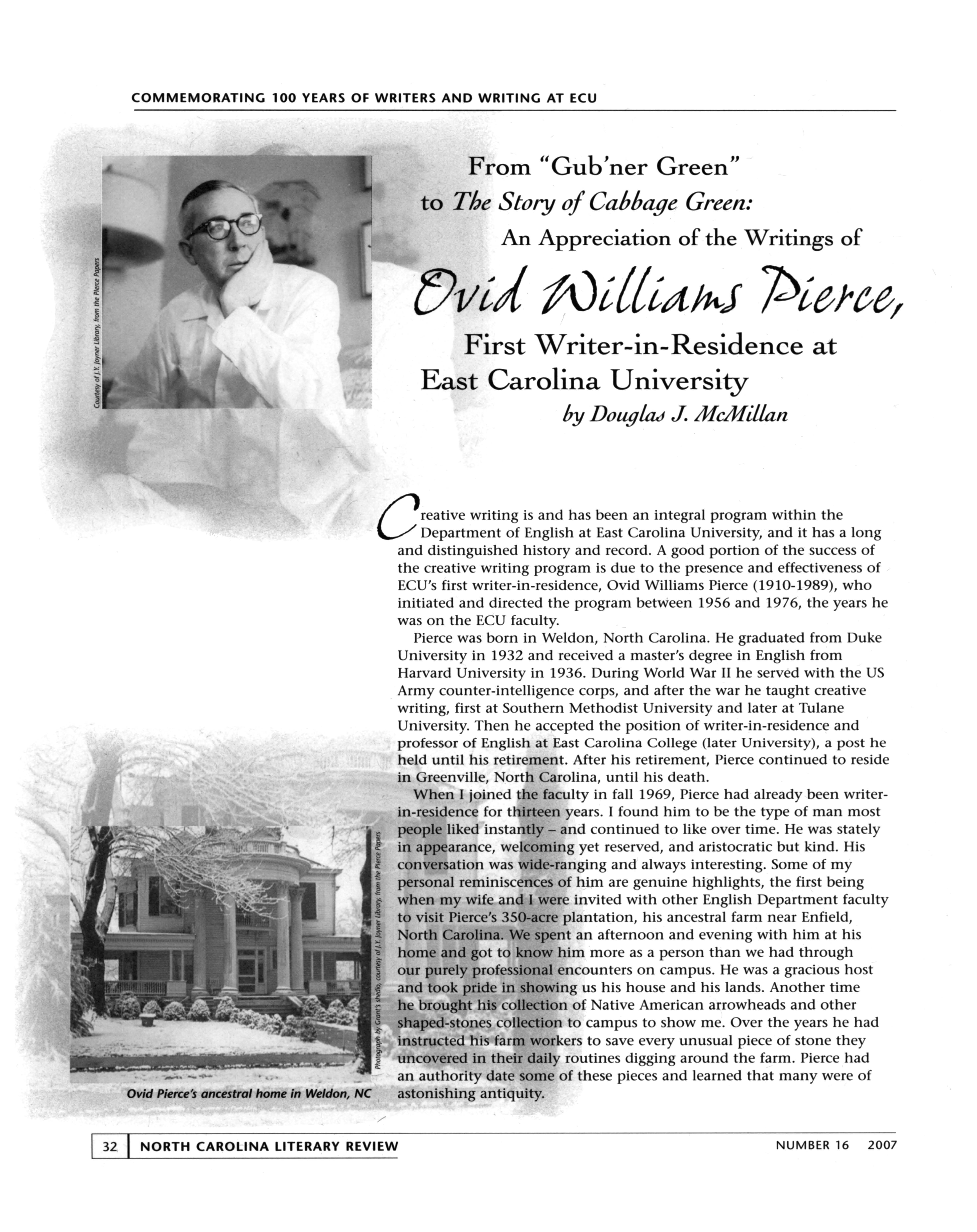Friday from the Archives: “From “Gub’ner Green” to The Story of Cabbage Green: An Appreciation of the Writings of Ovid Williams Pierce, First Writer-in-Residence at East Carolina University” by Douglas J. McMillan from NCLR 16 (2007)
In the 2007 issue Commemorating 100 Years of Writers and Writing at East Carolina University, McMillan writes about Pierce, someone we don’t hear much about today. “Creative writing is and has been an integral program within the Department of English at East Carolina University, and it has a long and distinguished history and record. A good portion of the success of the creative writing program is due to the presence and effectiveness of ECU’s first writer-in-residence, Ovid Williams Pierce (1910-1989), who initiated and directed the program between 1956 and 1976, the years he was on the ECU faculty.”
McMillan pulled from the Pierce papers housed within Joyner Library, as well as his own memories of working with Pierce in the English Department. About his body of work, McMillan states, “Ovid Pierce wrote about the places he knew and about the people he knew, often through daily contact. He has captured the region and its people in multiple transitions: from rural to increasingly urban, from place-bound and rooted to physically transient, from segregated to integrated, and from living in the past to moving forward to the future without forgetting the past. Pierce recognized the many dialects spoken in the region and recreated them with great accuracy. And along with the dialects, his writing has preserved much of eastern North Carolina folklore and folkways.”
Also in the issue is Pierce’s own speech, “A Region’s Face: Beyond the Stereotypes” presented at the second annual North Carolina Literary Forum, 4 April 1957, Raleigh, NC, with an introduction by NCLR intern Kristi Southern. Pierce starts his speech with:
“We are asked to describe the fictional possibilities in the east of North Carolina–that region between the fall of the rivers and the clash of waters on Diamond Shoals. We are not concerned at the moment with the Piedmont, with its universities, its towns overflowing up on farm and stream, its traffic ceaselessly tracing highways in the night. Nor, at the moment, are we concerned with the mountain landlocked within itself, concealing lovely green depths from the outside world. Our direction is east–to the old cradle of the state–the coastal plain. This we are asked to describe, to isolate as a region, to survey as if it were a separate world of its own.
How is one to describe the face of a land? Of any land? How are its features to be contained? Are we asked to believe that its character does lie there in a way that can be seen and heard? That mere glimpses of landscape and fragments of speech are revealing? That they do warrant one’s saying, “Here is the land. It is here and here.” Or, rather, shall it be recognized by its sound? The slow slug of its river waters upon mud- slick banks in spring, the rasp of the June bug on hot summer nights. Or, there remains for us what we are told of the past (as to persons, legends also adhere to land)–the recorded story of what has been. Here again do we discover patterns of thought that are safely definable, distinguishable from those elsewhere? Have old attitudes and concepts survived with such recurring regularity as to justify the claim that there is in a particular region a continuity of mind? WJ. Cash, in his Mind of the South, seems to confirm the extension of a social concept from one generation to another as being a particular burden for the Southern mind.
NCLR is proud to be part of the long tradition of writers at ECU and North Carolina. We plan to continue contributing to the rich literary culture of North Carolina for many more years.
Read both essays on Gale Cengage or purchase a copy of the 2007 issue.
